
Boating Basics Online is reader-supported. When you buy via our links, we may earn a commission at no cost to you. Learn more

How to Paint a Sailboat? – A Step-by-Step Guide
Written by J. Harvey / Fact checked by S. Numbers

Painting a sailboat hull not only lets you save money, but it can also be quite gratifying. Plus, learning how to paint a sailboat can be likened to taking that one important step of truly claiming your vessel as your own. I mean, they’re our darlings, right?
This simple guide teaches you how to paint the hull of a boat, including a sailboat’s. Overall, it’s not hard to grasp – just a bit tiring, and plenty of waiting is involved.
Table of Contents
Prepare the Following
Step 1. give the sailboat a thorough cleaning., step 2. start sanding the hull’s surface., step 3. prepare the primer, then apply it., step 4. prepare the paint, then start applying the topcoat and antifouling coat., the importance of painting your sailboat, how often do i need to paint my sailboat, some best paints to use for a sailboat, safety tips for painting.
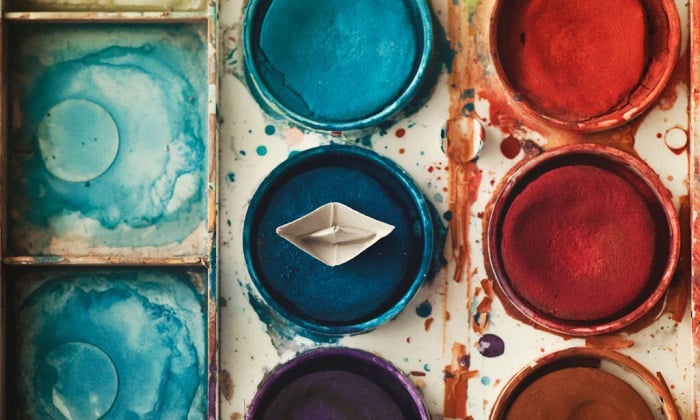
- Marine-grade paint
- Primer (epoxy recommended) and hardener
- Sandpaper (80-grit, 220-grit, and 400 grit)
- Cleaning cloth
- Masking tape
- Roller (or paint sprayer)
- PPEs such as gloves, a coat, and a respirator
Choose a workspace with good ventilation to avoid exposing yourself to fumes, which have many detrimental but highly avoidable side effects. Painting the boat on its trailer on a clear, dry day and positioning it so the paint won’t get direct sunlight exposure are ideal.
Practical Steps for Painting a Sailboat
This guide works well for fresh paint jobs and even if you’re repainting the boat.

Any dirt, debris, and grease should be taken care of in any sailboat paint job. Check for debris and algae clinging to the hull and the sailboat deck, and just use the brush and cloth to get it off.
Double-check parts of the keel because mud and seaweed tend to stick to it the most. If there are barnacles present, you may have to power wash them or any stubborn green stuff you encounter.
Dip the sponge in a mix of boat soap and water, then start scrubbing any stains. Afterward, give the sailboat a good rinse. Wait for it to dry.
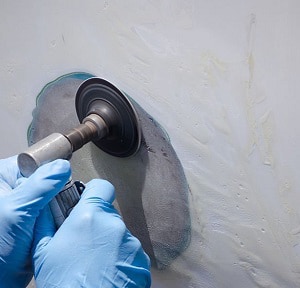
Put on your respirator and coat. Use an 80-grit or 100-grit to roughen the surface and remove any lingering trace of old paint by scrubbing in circular motions.
Then, grab the 220-grit to smoothen the surface more. That said, an 80-grit or 40-grit paired with a sander will do just as well, based on my experience every time I repaint a fiberglass boat .
You’d want the surface to be as even and smooth as possible before applying the first coat.

The epoxy primer helps to ensure that the paint will adhere well, too, so I recommend you don’t skip it. Epoxy also acts as a good sealant and prevents cracking and rust.
Before you apply it, put some masking tape over the areas of the hull that you don’t want the coats to go over. It will ensure even coats, too.
Every epoxy primer and hardener combination is different in one way or another. As such, follow what the manufacturer recommends when mixing. Be mindful of how quickly the mixture hardens.
Once you’re done with that step, use the roller to apply even coats of it over the whole surface of the hull. Depending on the size of your boat, this may take a while and can be tiring, so I suggest you ask for help.
Done? It’s time to wait a day to apply another layer. The next day, you can either apply another coat of primer (up to 4 coats is great) or proceed to the painting part.

Mix the paints according to the instructions.
You need to make sure the primer has dried before painting. I suggest two layers of topcoat followed by two equal coats of antifouling paint. But you can also skip to the antifouling paint immediately – your boat, your choice.
- Be sure to pick a good marine-grade paint like TotalBoat’s Alumipaint AF or Interlux’s Fiberglass Bottomkote Aqua. Better yet, you can just head to your local marine shop and ask for recommendations (trust me, they know their sailboat paint best).
- We’re not exactly doing something artsy here, like making an easy sailboat painting with acrylics. You want coats that can take a beating, so choose marine grade only.
Once you’re ready to work, use a roller or a sprayer to apply the paint. Personally, I’d suggest the latter choice because if you spray paint a boat, you’ll get a sleeker, more attractive finish, although it requires some skills.
Therefore, if you’ve never handled a sprayer, the best way to paint a boat would be with a roller. Here are some tips to ensure the best results:
- Pour the paint into the t
- Slightly dampen the roller with clean water.
- Lightly dip the roller into the paint so that no more than half of it is submerged.
- Run the roller on the paint tray’s ramp a few times to evenly distribute the pigment.
- Run the roller from the top to the bottom of the hull. Make sure you apply even pressure as you do so. Remember: the strokes should be parallel and uniform; under no circumstance should you change the stroke to a different pattern.
- Use a paintbrush to access cavities and holes on the hull that your roller can’t reach.
- Apply the suggested number of coats for each type of paint, taking care to sand with the 400-grit or higher with each However, make sure you confirm that it’s recommended by the paint’s manufacturer.

- The first is aesthetics. How can your gaze possibly not be arrested by an exquisitely painted sailboat sailing in the distance? It’s an automatic postcard image.
- Secondly but just as important (if not more), you’re protecting your baby from damage, barnacles, rot, and other nasty things, extending its life and boosting its value.
- It exercises your creativity. Try out some sailboat paint schemes available on sites like Pinterest, and you’ll know what I’m talking about.
I’ve certainly tried one or two of these ideas myself, but not on a skiff and jon boat that I made from scratch. My wife and buddies were positively mesmerized.
- Much like how videos on YouTube showing easy boat acrylic painting puts my mind at ease, I can say the same for when I’m painting sailboat hulls.
A lot of my friends who love to sail, fish, and paint sailboats on canvas say the same since they’re often more than willing to stop by and lend a helping hand during my paint days. We exchange sailboat painting ideas occasionally, and they like the method I’ve shared here.
As such, painting boats can be a way to relax your mind and help you connect with like-minded people. You may also learn helpful tips regarding sailing and boat maintenance along the way.
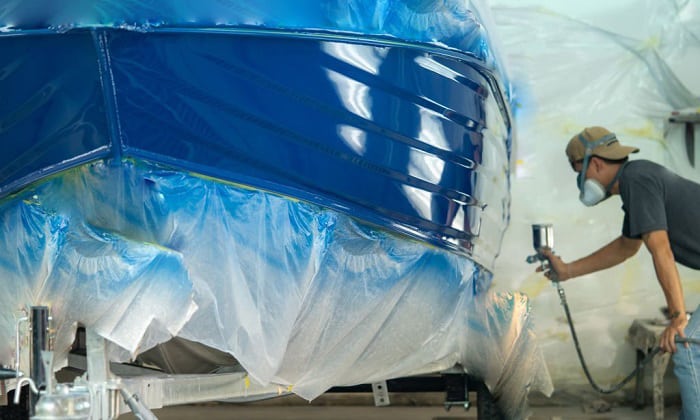
You need to paint your boat every year if you let it sit in the water all the time and the vessel shows signs of degradation.
That said, if you paint your sailboat with high-quality products, such as marine-grade paint, the coating can last for as long as 10 years, especially if you’re extra careful with your boat and have proper storage for it.
Besides the two brands I mentioned above, you can also try antifouling paints by Rust-Oleum. I just rotated between TotalBoat, Rust-Oleum, and Interlux because these three provided the best results among the sailboat paints I tested.
Rust-Oleum’s Topside Paint paired with the brand’s fiberglass primer work well with fiberglass hulls. But I can say the same for TotalBoat’s Topside Paint. To me, it’s really just whichever of the three is available on my local marine shop’s shelf. Besides choosing the right paint, you may also ask yourself how much it costs to paint a boat. Is it worth it? Check out this article to get the answer!

If you follow most of the preliminary preparatory steps I’ve shared here, you will be keeping yourself safe from start to finish.
- Wear the PPEs I said above every time you’re sanding and applying epoxy and paint on the surface.
- Read any warning labels on the paint and other chemicals you use, like acetone for drying the paint quickly. Handle it with care always.
- Learn how to dispose of your paint properly. It’d be even better if you learned how to recycle it.
- Beware of accidents that may happen while you’re doing the cleaning and prep work. I mean, I’ve hit my head on a sailboat mast while doing them, so I reckon the chance of such misfortunes happening isn’t zero, even on a paint job.
To recap everything I’ve said regarding how to paint a sailboat:
- Position your boat in a good workplace.
- Clean and sand its hull well using boat soap and water and sandpaper.
- Apply 4 coats of the primer, 2 coats of the topcoat, then 2 antifouling coats, or skip to the antifouling paint coat immediately.
- Decide how you’re going to apply the paint based on the finish you want and your skill in using each tool.
We wish you the best of luck with your painting project. If you want to share your results with us, feel free to reach out via the comment below.

“My intention from the first day establishing Boating Basics Online is to provide as much help as possible for boaters who want to experience a first safe and convenient trip. So feel free to join us and share your beautiful journeys to the sea!”
- How to paint a boat: A step-by-step guide
Painting your boat not only enhances its visual appeal but also protects it from the damaging effects of saltwater, sunlight, and other elements. Whether you have a sailboat, powerboat, or kayak, the principles of boat painting remain largely the same.
Assessing your boat's condition
Before you begin, evaluate your boat's current condition. Inspect the hull for any damage, scratches, or rust that may need to be addressed before painting. Make a list of necessary repairs and tackle them first.
Gathering the right tools and materials
To paint your boat successfully, you'll need a range of tools and materials, including paintbrushes, rollers, sandpaper, masking tape, drop cloths, and, most importantly, the appropriate marine paint.
Preparing the boat surface
Proper preparation is the key to a successful paint job. Start by cleaning the boat's surface thoroughly to remove dirt, grease, and old paint. Sand the surface to create a smooth and clean canvas for the new paint to adhere to.
Applying primer
Priming is a crucial step to ensure good paint adhesion and durability. Apply a marine-grade primer that is compatible with the paint you've chosen. Allow it to dry thoroughly as per the manufacturer's instructions.
Read our top notch articles on topics such as sailing, sailing tips and destinations in our Magazine .
A man taking care of his ship.
Choosing the right paint
Selecting the right type of marine paint is essential. There are different types of boat paint available, such as antifouling paint, topside paint, and bottom paint. Choose the one that suits your boat's needs and your intended use.
Applying the paint
Start by applying the paint to the boat's surface using a paintbrush or roller. Use long, even strokes, working from one end to the other. Be mindful of the weather conditions, as extreme temperatures and humidity can affect the paint's drying process.
Applying additional coats
For best results, you may need to apply multiple coats of paint. Follow the manufacturer's recommendations for drying times between coats. Applying multiple thin coats is often better than one thick coat.
Drying and curing
Allow the paint to dry completely before launching your boat into the water. The curing time can vary depending on the type of paint and environmental conditions. Follow the paint manufacturer's instructions for specific guidance.
Final touches and cleanup
After the paint has dried, remove any masking tape and clean your tools and equipment. Inspect your boat's finish for any imperfections, and make any necessary touch-ups.
Painting a boat requires careful planning, preparation, and attention to detail, but the results can be incredibly rewarding. Not only will your boat look like new, but it will also be better protected against the elements, ensuring many more enjoyable days on the water.
Whether you're a DIY enthusiast or a boat owner looking to maintain your vessel's beauty and functionality, this step-by-step guide on how to paint a boat will help you achieve a professional and long-lasting finish. So, roll up your sleeves, gather your materials, and give your boat the makeover it deserves. Happy painting!
So what are you waiting for? Take a look at our range of charter boats and head to some of our favourite sailing destinations .
How to Paint a Boat
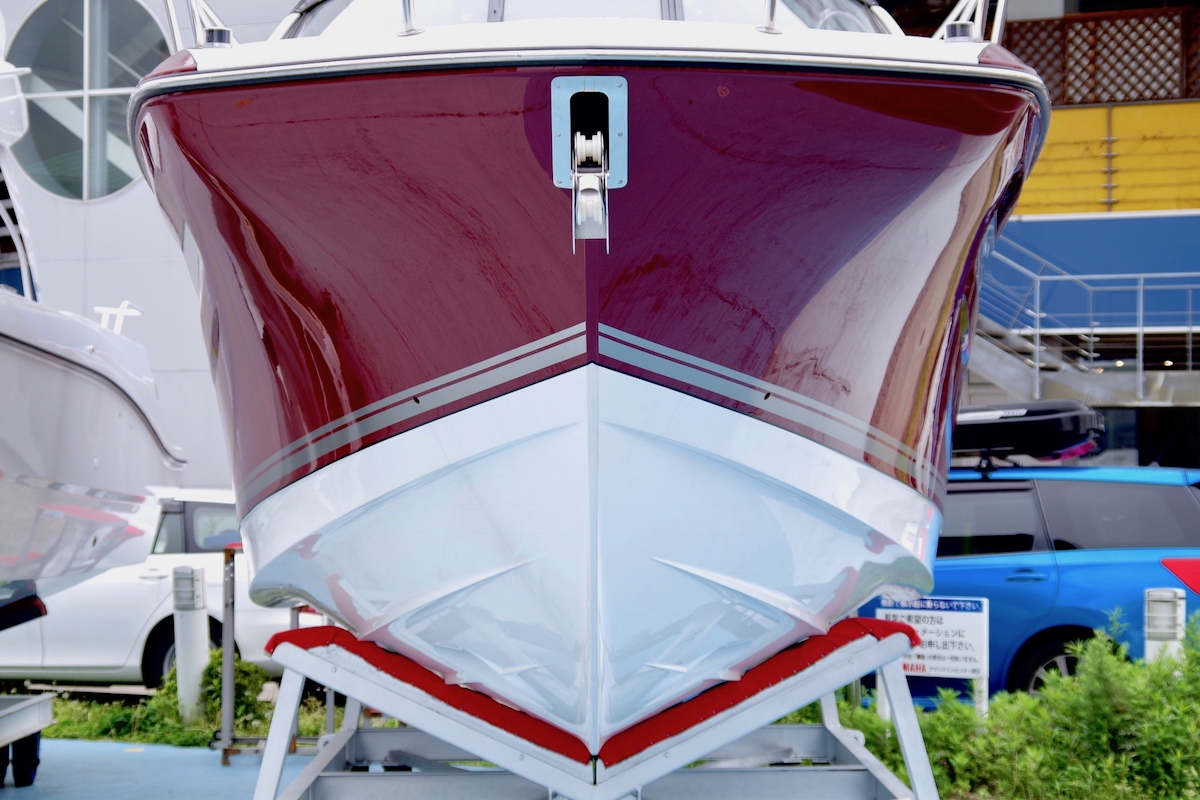
Learning how to paint a boat is easy, and if you want to make your boat look like new, you'll be surprised what a fresh layer of paint can do. Proper boat maintenance will go a long way in keeping your pride and joy looking great, but when that boat starts to appear aged, knowing how to paint a boat is the key to making it look like new again. And although painting a boat can be time-consuming and expensive, there’s no better way to improve an older boat’s appearance. While this is a rather complex process, we can boil it all down to these five basic steps.
How to Paint a Boat Step-by-Step:
- Remove all hardware (like rails, cleats, and vents) and/or any teak or wood trim on the boat.
- Repair any surface imperfections like chips, dings, or gouges.
- Prep the surface by washing, de-waxing, and thoroughly sanding it.
- Apply the primer, then the paint.
- Wax the boat from stem to stern to protect the new paint job.
Then, simply keep it clean, and rinse it thoroughly after use in saltwater. Remember, before you paint a boat always read the warning labels on all of the supplies and be sure to use the proper protective equipment.
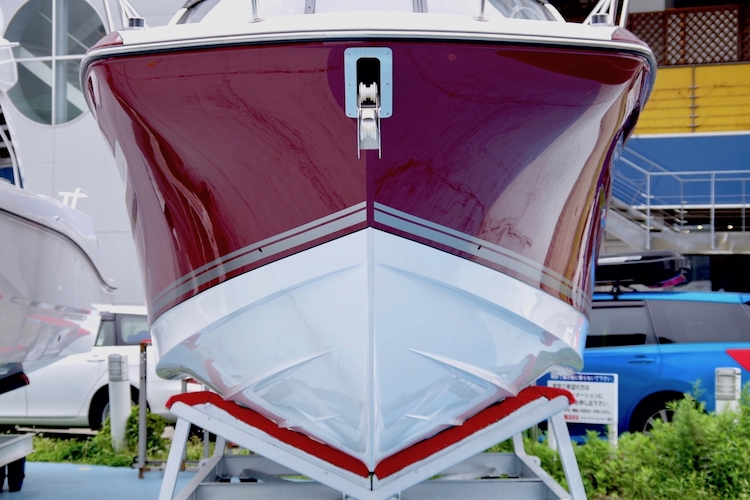
How to Paint a Fiberglass Boat
Painting fiberglass boats isn’t really much different from painting wood boats, except for the type of paint you’ll use and a few details in the prep and application. We should note that the very best finish can be attained by professionals who spray on the paint, rather than applying it with a brush and roller. However, anyone can do a bang-up job painting a boat if they make sure the surface has been properly prepped, and take care during the application.
Paints for Fiberglass Boats
- Single-Part Enamel Paints – These paints are easiest to apply and are less expensive than some other options. However, they also are subject to UV damage over time and the gloss doesn’t tend to hold up as well over the long haul especially if it isn’t constantly waxed and maintained.
- Single-Part Polyurethane Paints – Urethane paints are also easy to apply, don’t cost nearly as much as two-part polyurethanes, and have a long-lasting gloss.
- Two-Part Polyurethane Paints – These undisputedly look best and last longest. Many people would even argue they can out-shine a boat’s original gel coat. However, they are very expensive and are more labor-intensive, as they require mixing, an epoxy primer, and specific temperature and humidity levels for application.
Whichever of these you choose, job number-one is following the manufacturer’s instructions to a tee. We can’t lay out all the details here because each paint has its own specific requirements. The bottom line, however, is that each has its own instructions that can be quite exacting. And remember that like any paint job, good prep work is the key to success. De-waxing is one of the most important factors, because even a tiny amount of wax will prevent the paint from adhering to the fiberglass. Either acetone or a dedicated wax-stripper can be used but in either case, be sure to do a thorough job.
Tips for Painting a Fiberglass Boat
- Most people will use a standard “roll and tip” method for painting large surface areas of a boat. This requires two people and both rollers and brushes. As one person rolls out the paint, another follows behind with a brush and lightly strokes across the paint to brush out the roller pattern.
- One important tip for creating the best surface is to apply multiple, thin, consistent coats, as opposed to one or two thick ones. Three coats of paint is generally considered best.
- Another important tip to keep in mind: be sure to allow the proper amount of cure-time between coats (again following the manufacturer’s recommendations). And if the work takes place outdoors keep an eye on the weather to ensure the temperature and humidity will be acceptable and consistent throughout the entire timeframe.

How to Paint a Boat Bottom
Painting a boat bottom is a completely different experience than painting the boat’s upper hull and topsides. In this case you’ll want an anti-fouling paint that prevents marine growth, and there are countless versions to choose from. Read Antifouling Paints: Which Paint is Best For Your Boat to learn more about some of the different options.
Here’s the good news: learning how to paint a boat bottom is much easier than it is for the rest of the boat, because bottom paint tends to be simpler to apply.
- If the bottom is fresh gel coat, the same sort of prep work (de-waxing and sanding) is necessary.
- If you’re applying over old bottom paint, you can skip the de-waxing process and simply sand or power wash away any old or loose paint. Also, you won’t need to roll and tip; most people skip the tip part of this equation since the bottom will be underwater anyway, and simply roll the paint right on.
- There is, however, one additional factor to applying bottom paint to a boat: you may need to properly time the boat’s launch. Some paints have a minimum dry time but a maximum time as well, and will need to be launched within a certain window.
How to Paint a Boat Hull
Painting a boat’s hullsides is usually a lot easier than painting the topsides, simply because you’re dealing with a large, smooth surface area. There will only be minimal hardware to remove (in this case you may want to simply protect it with masking tape, though this rarely provides as good a final finish), and you won’t have to worry about angled surface areas or tight corners.
There is one variable to note, however, about painting a boat hull. You will be working on a more or less vertical surface, and if you apply the paint too thickly, drips and runs will result. So it’s very important to apply the pint evenly and thinly.
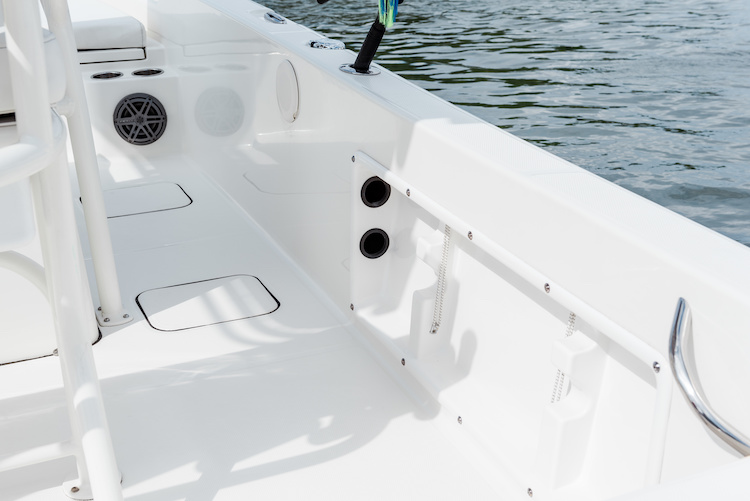
How to Paint a Boat with Non-Skid
Molded fiberglass non-skid and non-slip surfaces can’t be painted the same way as the rest of your boat. It’s impossible to sand or apply paint between the tiny imprints, and even if you did paint it, it would wear unevenly as people walk across the top of the pattern without ever touching between the raised surfaces. But that doesn’t mean you can’t make that old non-skid look like new again.
- The best way to paint non-skid is to apply a textured compound. There are several on the market designed specifically to paint a boat deck. They have some sort of grit or tiny rubberized pellets mixed in with the paint, to give the boat’s deck a fresh look but still maintain its non-slip properties.
- Once again, each has its own set of specific application instructions, prep work is key, and several coats are usually necessary.
- On additional variable you need to know about is the roller; since these paints have solids mixed in, you usually need to use a roller brush specifically designed to spread them.
Yes, painting a boat is a big, time-consuming job. Sure, it requires some expense. But remember, there’s no better way to make an older boat look new again than to give it a fresh paint job.
Editor's Note: Remember that many paints, primers, and wax strippers emit chemical fumes, and sanding can also create potentially harmful conditions for both you and the environment. Before you paint a boat always read the warning labels on all of the supplies and be sure to use the proper protective equipment.
Learn More in our Boat Maintenance Guide
Looking for more on boat maintenance and upkeep? Read...
- Antifouling Paints: Which Paint is Best for Your Boat?
- Boat Storage: What Are My Options?
- How to Winterize a Boat
- Spring Start-Up Checklist

Join Our Newsletter!
Get community news, buying bargains, and how-to guides at your fingertips.
- PRO Courses Guides New Tech Help Pro Expert Videos About wikiHow Pro Upgrade Sign In
- EDIT Edit this Article
- EXPLORE Tech Help Pro About Us Random Article Quizzes Request a New Article Community Dashboard This Or That Game Popular Categories Arts and Entertainment Artwork Books Movies Computers and Electronics Computers Phone Skills Technology Hacks Health Men's Health Mental Health Women's Health Relationships Dating Love Relationship Issues Hobbies and Crafts Crafts Drawing Games Education & Communication Communication Skills Personal Development Studying Personal Care and Style Fashion Hair Care Personal Hygiene Youth Personal Care School Stuff Dating All Categories Arts and Entertainment Finance and Business Home and Garden Relationship Quizzes Cars & Other Vehicles Food and Entertaining Personal Care and Style Sports and Fitness Computers and Electronics Health Pets and Animals Travel Education & Communication Hobbies and Crafts Philosophy and Religion Work World Family Life Holidays and Traditions Relationships Youth
- Browse Articles
- Learn Something New
- Quizzes Hot
- This Or That Game New
- Train Your Brain
- Explore More
- Support wikiHow
- About wikiHow
- Log in / Sign up
- Cars & Other Vehicles
- Boat Building
How to Paint a Boat
Last Updated: December 22, 2023 Approved
wikiHow is a “wiki,” similar to Wikipedia, which means that many of our articles are co-written by multiple authors. To create this article, 13 people, some anonymous, worked to edit and improve it over time. There are 7 references cited in this article, which can be found at the bottom of the page. wikiHow marks an article as reader-approved once it receives enough positive feedback. In this case, 92% of readers who voted found the article helpful, earning it our reader-approved status. This article has been viewed 209,088 times. Learn more...
As your boat begins to crack and fade after several years in the water, you have two choices -- hire a professional boat yard to paint it again or do it yourself. Painting a boat takes a lot of time and effort, from preparing the hull to buying the paint, but anyone can do it with some simple equipment and a few open afternoons.
Prepping the Boat

- Anything you cannot remove you should cover in painter's tape to keep clean and protected.

- Generally, running your finger along the surface, top or bottom, will tell you if there is still a coating-- it feels like a candle or a freshly waxed car.
- If you are in any doubt about the coating, go over the boat again -- paint will not stick to this waxy surface, so it all needs to go.

- Make sure you fill in any holes with marine-grade epoxy, found near the marine paint in hardware and boat stores.

- If the old coat of paint is flaky or damaged you will need to strip it and sand it away entirely.
- If the old paint is a different type than the one you plan to apply (non-vinyl vs vinyl paint), then remove it entirely.
- Never use a belt sander on your boat
- Warning: wear a respirator and eye protection when sanding, as paint chips are toxic. [5] X Research source
Painting the Boat

- When available, paint your boat in a covered area.

- Two step polyurethane paint, while longer lasting, takes precise mixing and application techniques to use.
- Most gel coats, excepting expensive, high-end options, will fade in 1-2 years.

- After the first coat has dried, lightly sand the boat (300-grit sandpaper) and apply another coat. [8] X Research source

Community Q&A
- Take your time cleaning and sanding -- preparing your boat can take as much as 80% of your time, but it will lead to a better final product. Thanks Helpful 0 Not Helpful 0
- If you are uncomfortable with any part of this process, especially sanding, call a professional boatyard to get a price quote for painting. Thanks Helpful 0 Not Helpful 0

- Dust and debris while sanding can be highly toxic. Always wear protection for your eyes, nose, and mouth.
Things You'll Need
- Marine paint
- Paintbrush or roller
You Might Also Like

- ↑ http://americanboating.org/clean_boat_cleaning.asp
- ↑ http://www.yachtsurvey.com/Paint.htm
- ↑ https://www.boatus.com/magazine/2011/december/diy.asp
- ↑ https://www.boatus.com/magazine/2017/april/10-steps-to-the-perfect-topside-paint-job.asp
- ↑ http://www.boatus.com/boattech/articles/painting-tips.asp
- ↑ https://www.boats.com/how-to/how-to-paint-a-boat/
- ↑ https://uk.boats.com/how-to/boat-painting-guide/
About This Article
Before painting a boat, start by removing the boat from the water and cleaning the surface with a high-pressure hose. Then, sand the boat with 80-grit sandpaper and brush on a coat of primer to create a smooth, even surface. Afterwards, apply 1 coat of one step polyurethane paint, let it dry, then sand the surface with 300-grit sandpaper to remove any spots or paint bubbles. Finally, apply 2 to 3 more coats of paint, making sure to sand the boat after each coat has dried. To learn more, including how to choose the right paint for your boat, scroll down. Did this summary help you? Yes No
- Send fan mail to authors
Reader Success Stories
Jason Jensen
Sep 26, 2016
Did this article help you?

Austen Clark
Sep 29, 2018
Michael Irwin
Apr 5, 2017
Simon Casey
Dec 2, 2016
Jerry Jones
Aug 28, 2016

Featured Articles

Trending Articles

Watch Articles

- Terms of Use
- Privacy Policy
- Do Not Sell or Share My Info
- Not Selling Info
wikiHow Tech Help Pro:
Develop the tech skills you need for work and life

Master the Art of Painting a Sailboat on Canvas with These Step-by-Step Instructions
Alex Morgan

Painting a sailboat on canvas can be a captivating and rewarding artistic endeavor. Whether you are an experienced artist or a beginner, this article will provide you with the necessary guidance to create a stunning sailboat painting. We will cover the materials and tools needed, the process of preparing the canvas, sketching the sailboat, blocking in colors, adding details and texture, and the finishing touches to finalize your painting. We will share some tips and tricks to help you along the way. So, let’s dive in and explore the exciting world of sailboat painting on canvas!
Key takeaway:
- Painting a sailboat on canvas allows for creativity and expression: Painting a sailboat on canvas provides an artistic outlet to capture the beauty of the sea and sailing while expressing individual style and interpretation.
- Importance of using the right materials and tools: To achieve desired results, it is important to gather the necessary materials such as brushes, paints, and canvas. Using quality tools ensures better control and precision in creating the sailboat painting.
- Techniques for creating a realistic sailboat painting: Preparing the canvas, sketching the sailboat, blocking in colors, adding details and texture, and applying finishing touches are essential steps in creating a realistic and visually appealing sailboat painting on canvas.
Materials and Tools Needed
“When painting a sailboat on canvas, you will require the following materials and tools:
• Canvas: It is best to select a size that suits your preferences and fits well with your desired composition.
• Acrylic paints: These are highly recommended for their vibrant colors and rapid drying time.
• Paintbrushes: Prepare different sizes and shapes of brushes for detailed work and broad strokes.
• Palette or palette paper: This is necessary for mixing and blending colors effectively.
• Easel or a flat surface: Either of these options is needed to hold the canvas in a comfortable position while you paint.
• Palette knife: Using a palette knife will be helpful in creating texture and adding dimension to your painting.
• Water container: Fill this container with water so that you can rinse your brushes and thin down paints if required.
• Palette cups: It is useful to have palette cups for keeping your paint colors separate and organized.
• Masking tape: Make use of masking tape for achieving clean edges and to protect specific areas of the canvas.
• Pencil or charcoal: Use either a pencil or charcoal to sketch the sailboat and outline the composition.
• Reference photo: To guide you accurately, find a reference image of a sailboat.”
Preparing the Canvas
To prepare the canvas for painting a sailboat, follow these steps:
1. Start with a clean canvas. Use a cloth or brush to remove dust or debris.
2. Apply a layer of gesso to prime the canvas and create a smooth surface for painting. Use a wide brush to evenly spread the gesso.
3. Allow the gesso to dry completely. Check the instructions on the gesso product for specific drying times.
4. Sand the surface. Gently sand the dried gesso with fine-grit sandpaper to remove roughness and create an even texture.
5. Remove any dust. Use a cloth or brush to remove sanding residue from the canvas.
6. Apply a second layer of gesso for a smoother painting surface. Repeat the process of applying and drying the gesso.
To enhance canvas preparation, consider these suggestions:
– Experiment with different textures. Mix sand or other materials with the gesso to create interesting textures on the canvas.
– Use colored gesso. Instead of white gesso, try using colored gesso to add a unique base color to your canvas.
– Prime the sides of the canvas. Apply gesso to the sides of the canvas as well to ensure a cohesive look for your artwork.
Sketching the Sailboat
When sketching the sailboat, follow these steps for a successful depiction:
1. Observe the sailboat closely, noting its shape, size, and proportions.
2. Begin your sketch by lightly drawing the basic outline using straight lines for the hull and triangles for the sails.
3. Add more details, such as the mast, rigging, and distinguishing features.
4. Pay attention to the placement of the sails and their folds to create movement.
5. Continue adding more details like windows, doors, and other elements.
6. Use shading techniques to give depth and dimension, adding shadows for a realistic effect.
7. Once satisfied , move on to painting the sailboat on canvas.
For a more dynamic sketch, try different positions and angles to capture the motion on the water. Practice regularly to improve your ability to accurately depict the essence of the sailboat. Over time, you’ll be able to create beautiful sailboat sketches on canvas.
Blocking in Colors
Blocking in colors is a crucial and fundamental step when painting a sailboat. It is important as it establishes the composition and creates a solid foundation for the artwork. To execute this process effectively, follow these steps:
1. Start by preparing your canvas. Use a medium-sized brush or palette knife to apply a thin layer of gesso or acrylic paint . This will ensure that the surface is smooth and ready for the next steps.
2. The next step is to choose your base colors . Select the main colors for the water , sailboat , and sky . These colors will serve as the starting point for the rest of your painting.
3. Once you have your base colors, begin by blocking in the background . Use broad strokes to apply the paint and establish the basic shapes and tones of the painting. This will give you a general idea of how the final piece will look.
4. Moving on, focus on blocking in the sailboat . Use smaller brushes or a palette knife to add details and refine the shapes of the sailboat. Pay attention to the smaller elements and ensure they are accurately represented.
5. To create smooth transitions and add depth and dimension to your painting, utilize blending and layering techniques . Use a blending brush or, if you prefer, your fingers to blend colors together. Layering paints will provide a richer and more dynamic appearance.
6. Take a step back and assess your work. Make any necessary adjustments to the colors, tones, or shapes. If certain areas require more intensity, consider adding another layer of paint to enhance their vibrancy.
It is important to keep in mind that blocking in colors is only the initial stage of the painting process. As you add further layers and details, your sailboat artwork will come to life.
Adding Details and Texture
Adding details and texture to your sailboat painting brings it to life and creates depth and realism. Here are the steps to follow:
– Mix small amounts of paint to create different shades, tones, and colors. Use various brushes, including small detail brushes, for intricate details.
– Start by incorporating adding details to the sailboat itself. Paint the outline of the boat with a fine brush and add smaller details like windows, ropes, and flags.
– Focus on incorporating texture to the water. Use a palette knife or thick brush to create waves, ripples, and movement. Vary the brushstrokes and direction for a realistic effect.
– Incorporate depth to the sky by layering different shades of blue or other colors. Use a dry brush or sponge to create clouds or a soft, atmospheric effect.
– Continue adding details to surrounding elements like distant hills, rocks, or other boats. Use light and dark shades to create shadows and highlights.
– Evaluate your painting from different angles and make necessary adjustments or additions to enhance the details and texture.
By following these steps and paying attention to details and texture , you can create a captivating and realistic sailboat painting on canvas.
Finishing Touches and Finalizing the Painting
When finalizing a painting, it is important to follow these crucial steps for finishing touches and completing the artwork:
1. Inspect the canvas: Thoroughly examine the painting to identify areas that require touch-ups or corrections, such as smudges, uneven lines, or missed details.
2. Add highlights and shading: Enhance the depth and dimension of the artwork by incorporating highlights in areas that catch the light, as well as shading for creating shadows and contrast.
3. Fine-tune colors: Achieve the desired hues and tones by making small adjustments to the colors. Add minimal amounts of paint to ensure color balance and make any necessary tweaks for achieving harmony.
4. Sign your artwork: Establish ownership and authorship of the painting by adding your name or signature, which adds a personal touch.
5. Protect the painting: Apply a layer of varnish or sealant to safeguard the artwork from dust, moisture, and harmful UV rays. This not only enhances the colors but also provides the finishing touch for a professional appearance.
In addition, consider these final suggestions:
– Step back and appreciate your work, admiring the intricate details and composition you have created.
– Consider framing the artwork using a frame that complements its style and colors, adding an extra touch of elegance.
– Share your artwork with others by displaying it in your home, participating in exhibitions, or selling it to art enthusiasts who truly appreciate your talent.
Remember, these steps and suggestions are vital for putting the finishing touches and finalizing your painting.
Tips and Tricks for Painting a Sailboat on Canvas
When painting a sailboat on canvas, it’s important to follow these tips and tricks in order to enhance your artistic process. First, consider the size of the sailboat and select a canvas size that allows you to capture all the details without feeling cramped. Next, study the colors of the sailboat, sky, and water, and choose a harmonious color palette that reflects the scene realistically or creatively. Before starting the painting, create a rough sketch of the sailboat and its surroundings to help with accurate placement and proportions. Pay attention to unique features like the rigging, mast, and sails as adding these details will bring authenticity and depth to the artwork. Use shadows and highlights to create depth and a three-dimensional appearance for the sailboat, water, and sky. Employ fluid brushstrokes to imply movement and texture in the water, giving the painting a dynamic feel. Experiment with different painting techniques to achieve different effects and textures in your artwork.
I once painted a sailboat on canvas using these tips and tricks, and by carefully considering composition , color palette , and attention to detail, the final painting captured the serenity and beauty of the sailboat gracefully gliding across the sea. The play of sunlight on the sails and the gentle ripples in the water truly brought the artwork to life, evoking a sense of tranquility and adventure.
Some Facts About How To Paint A Sailboat On Canvas:
- ✅ Painting a sailboat on canvas requires a careful selection of colors and brush techniques.
- ✅ Many artists use acrylic or oil paints to create vibrant and realistic sailboat paintings.
- ✅ Creating texture and capturing the movement of water and sails are key elements in painting a sailboat on canvas.
- ✅ Learning how to properly blend colors and create shadows is essential for adding depth and dimension to the sailboat painting.
- ✅ There are various tutorials and online resources available that provide step-by-step guidance on how to paint a sailboat on canvas.
Frequently Asked Questions
How do i cancel contracts on youtube.
To cancel contracts on YouTube, you can follow these steps:
- Log in to your YouTube account.
- Navigate to your Creator Studio.
- Go to the “Channel” tab and click on “Advanced”.
- Scroll down to the “Contract” section.
- Click on the “Terminate” button next to the contract you want to cancel.
- Follow any additional steps or instructions provided to complete the contract termination process.
How can I test new features on YouTube?
If you want to test new features on YouTube, you can do the following:
- Go to your YouTube account settings.
- Scroll down to the “Test Features” section.
- Toggle on the option to “Enable Test Features”.
- Save your changes.
- You will now have access to any new features that are being tested on YouTube.
Where can I find the guidelines and safety information for YouTube?
You can find the guidelines and safety information for YouTube by following these steps:
- Go to the YouTube website.
- Scroll down to the bottom of the page.
- Click on the “Guidelines & Safety” link.
- You will be directed to a page with detailed guidelines and safety information for using YouTube.
What is the NetzDG transparency report on YouTube?
The NetzDG transparency report on YouTube provides information about how YouTube handles complaints related to the Network Enforcement Act (NetzDG). It includes data on the number of complaints received, actions taken by YouTube in response to the complaints, and any other relevant information regarding compliance with the NetzDG.
Who owns the copyright for YouTube until 2023?
Google LLC owns the copyright for YouTube until 2023.
How does YouTube work?
YouTube is a video-sharing platform where users can upload, view, and share videos. It allows content creators to create and upload their videos, which can be accessed by users worldwide. Users can search for videos, subscribe to channels, leave comments, and interact with the YouTube community. YouTube generates revenue through advertising and offers various features and resources to support creators.
About the author
Leave a Reply Cancel reply
Your email address will not be published. Required fields are marked *
Save my name, email, and website in this browser for the next time I comment.
Latest posts

The history of sailing – from ancient times to modern adventures
History of Sailing Sailing is a time-honored tradition that has evolved over millennia, from its humble beginnings as a means of transportation to a beloved modern-day recreational activity. The history of sailing is a fascinating journey that spans cultures and centuries, rich in innovation and adventure. In this article, we’ll explore the remarkable evolution of…

Sailing Solo: Adventures and Challenges of Single-Handed Sailing
Solo Sailing Sailing has always been a pursuit of freedom, adventure, and self-discovery. While sailing with a crew is a fantastic experience, there’s a unique allure to sailing solo – just you, the wind, and the open sea. Single-handed sailing, as it’s often called, is a journey of self-reliance, resilience, and the ultimate test of…

Sustainable Sailing: Eco-Friendly Practices on the boat
Eco Friendly Sailing Sailing is an exhilarating and timeless way to explore the beauty of the open water, but it’s important to remember that our oceans and environment need our protection. Sustainable sailing, which involves eco-friendly practices and mindful decision-making, allows sailors to enjoy their adventures while minimizing their impact on the environment. In this…
- BOAT OF THE YEAR
- Newsletters
- Sailboat Reviews
- Boating Safety
- Sailing Totem
- Charter Resources
- Destinations
- Galley Recipes
- Living Aboard
- Sails and Rigging
- Maintenance
- Best Marine Electronics & Technology

How to Paint Sailboat Decks
- By Tom Zydler
- Updated: March 14, 2013
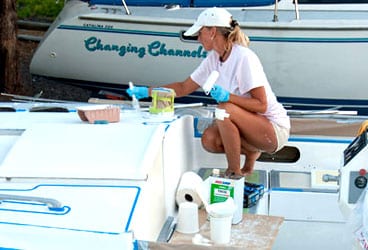

Painting a sailboat
Janet Van Leuwen and Steve Van Wig own a Whitby 42. Looking at their beautiful, well-groomed ketch, you’d never guess it was built in 1982. The name on the stern, Lunacy , may be the only hint of the incredible amount of work that the couple has put into rejuvenating their boat. Bringing the decks and the coachroof top to their present glory was a large part of the project, as these tasks would’ve been on any glass boat more than 25 years old. This is how they did it. And frankly, this is how it should be done.
Before the couple could begin doing any prep work for painting, the deck hardware had to be removed. They needed access to tight spaces where the horizontal deck surface turned into vertical bulwarks, around the masts’ partners, near the windlass base, and so on. (They also removed the chainplates, which needed attention as a separate project.) Out came all stanchions, their bases, various padeyes, winches—anything and everything, in fact, that could obstruct the power sanders required to remove the worn-down, cracking, original nonskid pattern. Steve then used silicon sealant to plug all the fastener holes that would be reused; silicon repels paint, so the fastener locations would be visible when they began reinstalling the hardware.
Donning breathing masks and kneepads, the couple spent days grinding the old surfaces with 80-grit discs. Using thick foam pads on machines running at high rpm prevented any gouging in the laminate. Smaller sanders (both round and square) helped them to negotiate tight turns; at times, they resorted to manual sanding blocks. Working with thickened polyester and epoxy resins, Steve filled several hairline cracks and dings. They then sanded this filler with 80-grit, then 100-grit, and finally 120-grit sandpaper to achieve a smoother surface before vacuuming up all the accumulated dust.
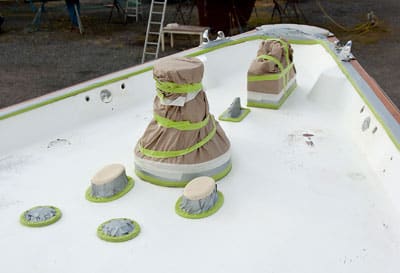
Next, to keep paint drips off teak handrails, the windlass, and the portholes, they masked these with heavy paper and tape. Right after the final wipe with a cleaning solvent, they took two days to roll and brush on two coats of epoxy primer, the base for the final topcoat. Over the next few days, the primed surfaces were sanded with 120-grit paper, followed again by vacuuming and hosing the resulting dust. Afterward, Janet cleaned all the surfaces with non-sticky tack cloths designed for multipart polyurethanes.
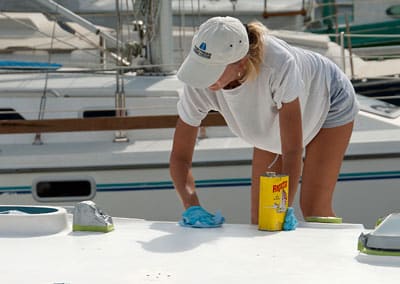
At this juncture, Steve identified and outlined the future nonskid areas, then spent a couple of days taping their inner edges with long-life 3M masking tape. At the corners, joining short lengths of tape on tight curves required meticulous care. After they wiped everything with cleaning solvent, they applied the first coat of multipart polyurethane to all the surfaces outside the future nonskid. Two more topcoat applications followed within allowable, 16-hour intervals. After sanding with 220-grit paper, dusting, using the tack rag, and wiping the solvent, they rolled and brushed on the fourth and final topcoat. The solvent-resistant, ultra-smooth, high-density foam-roller covers and quality brushes delivered the best finish. Working in the hot Florida sun required frequent additions of brushing reducer.

After allowing 48 hours to fully cure, they removed the masking tape. Fresh tape was then applied along the outside margins of the nonskid areas. All was ready for applying the nonskid coats. But first Steve spent a few days experimenting. He mixed his own color tints—too dark, and you couldn’t walk barefoot on the sun-heated deck; too white, and the deck glare was intolerable.
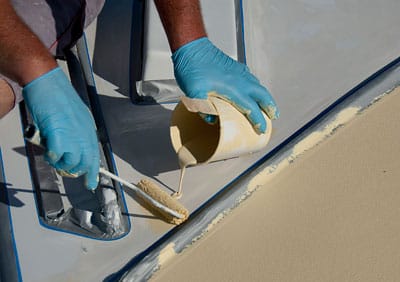
Also, he tested paint combined with various nonskid additives on scrap plywood; very coarse grit could damage human skin if a sailor knelt or fell on deck. He decided to combine equal amounts of coarse and fine grit. Significantly, this mixture prevented the coarse grit from settling down in the paint in lumps. On the big day, Steve and Janet mixed the activator with the paint base in a large container, added the correct nonskid grit, poured in the brushing reducer, and thoroughly stirred it all. After pouring small dollops within a taped area, Steve spread it out with a roller with Janet assisting, adding more paint or grit as necessary. She also wiped up Steve’s occasional paint drips with a solvent-soaked rag. The work went quickly and smoothly, though constant stirring of the paint/grit mixture was absolutely vital.
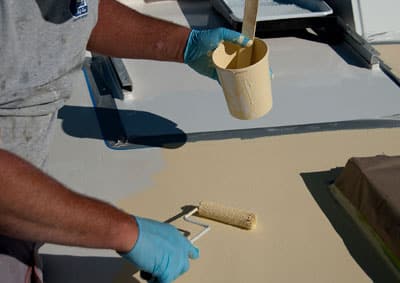
Twenty-four hours passed before heavy, late summer rain rolled in. By then, the paint had cured hard, and the coachroof was finished. They then repeated the whole operation to paint the deck. Nobody said rejuvenating a classic-plastic yacht would be quick or easy. But when the entire project was finished and Lunacy ‘s deck sparkled, the two sailors realized that all their meticulous efforts had been well worth it.

Steps:** 1. In preparation for the job, much of the deck hardware, including the stanchions, had to be removed. The remaining gear was carefully and completely covered and masked. 2. All the fastener holes were filled with silicon sealant, and the couple spent days grinding the old surfaces. Then Janet used a solvent wash to ensure a strong bond with the primer paint. 3. After dings and cracks were repaired and sanded, two coats of epoxy primer were applied. 4. Following another round of sanding, vacuuming, cleaning, and taping, the couple rolled and brushed on a fresh coat of Awlgrip topcoat. 5. After four coats of Awlgrip, it was time for the nonskid. First, Steve experimented with colors and grits. Once under way, he poured on a dollop of pre-mixed paint and spread it evenly. Note the paint stirrer, which was used to prevent the grit from settling. 6. Stirring frequently, to make sure the coverage was even in each masked area, Steve worked quickly and efficiently while Janet addressed small splashes with a solvent-soaked cloth. 7. Voilà! Once the masking tape was removed, the fresh decks fairly glistened.
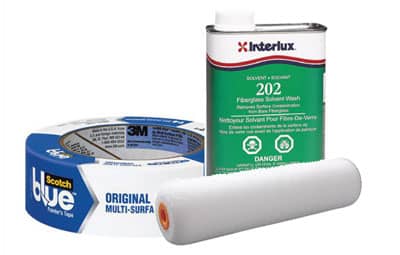
What You’ll Need: • Hook-and-loop sanding discs, sized to fit the sander pads • Sheets of sandpaper of grits 80, 100, 120, 180, 220, and 320 • 3M masking tape in widths of 1/2 inch (No. 256), 1 inch (No. 2090), and 2 inches (No. 225) • Gerson synthetic tack cloths • Roller frames and roller covers, with phenolic cores: ultra-smooth, high-density 4-inch and 6-inch roller covers (available from Home Depot; for the primers and topcoats) and Yellow stripe 3/8-inch nap (from West Marine; for the nonskid paint mixture) • Good-quality varnishing brushes • Cabisil (colloidal silica) thickening agent for making fairing putty with epoxy or polyester resin • Plastic putty knives • Interlux Fiberglass Solvent Wash 202 (for cleaning surfaces) • M.E.K. solvent (for cleaning all brushes) • Disposable paper/plastic pails of various sizes • A dozen wooden paint stirrers • Interlux Epoxy Primekote • Awlgrip topcoat (with Brushing Reducer and brushing converter) • Awlgrip Griptex nonskid additive (fine and coarse grades) • Ryobi and Makita random orbital sanders • Ryobi 6-inch palm polisher (used with a foam pad as a sander in complex spaces) • 3M breathing dust masks, ear protection, and solvent-resistant gloves
Longtime CW contributor Tom Zydler and his wife, Nancy, plan on spending this summer exploring the coast of Labrador aboard their Mason 44, Frances B .
- More: boat maintenance , How To , maintenance
- More How To

3 Clutch Sails For Peak Performance

It’s Time to Rethink Your Ditch Kit

8 Ways to Prevent Seasickness

How To De-Winterize Your Diesel Engine

Grenadines Boat Hijacking Suspects Charged with Murder

13 Hours in a Life Raft

Meet the Bali 5.8

Celebrating a Classic
- Digital Edition
- Customer Service
- Privacy Policy
- Terms of Use
- Email Newsletters
- Cruising World
- Florida Travel + Life
- Sailing World
- Salt Water Sportsman
- Sport Fishing
- Wakeboarding
You are using an outdated browser. Please upgrade your browser or activate Google Chrome Frame to improve your experience.
- Account details
No products in the cart.

Boat Owner’s Guide: How To Prepare and Paint a Boat
- Blog Boat Owner’s Guide: How To Prepare and Paint a Boat

Boats are exposed to a variety of elements and objects — water and all the vegetation and organisms that come with it, UV rays of the sun, extreme temperatures, sand, trailers, docks and more. It’s no surprise the paint on boats begins to crack and fade over time. When this happens, a fresh coat of paint can make a world of difference, but only if it’s done properly.
With the exposure to all these elements and objects, boats end up with peeling paint and dents. Simply painting over this uneven, damaged surface will leave you with an ugly paint job that is susceptible to peeling — and an expensive bill to fix it. They key to getting your boat like new is in the preparation. According to Sailing World, 75 percent of a successful paint job is the preparation . That means taking time to inspect your boat for problem areas, scrape off peeling paint, sanding, feathering, filling and priming — all before you apply your first coat of paint.
What you’ll need to get started:
- Protective glasses
- Tack cloth/rag
- Putty knife
- Dewaxing solvent
- Epoxy filler
- Random-orbital sander or finishing sander
- 80- to 120-grit sandpaper
- Paint roller
- Topside boat paint
- Boat bottom paint

How to Prepare a Boat’s Hull for Painting
If you’ve been wondering how to prepare a boat for painting, there’s no short answer. The reality is the actual painting of your boat takes the least amount of time — the preparation is the time-consuming part. However, with the right preparation, your coat of paint will last several years and make your boat look like new. So how do you paint a boat hull?
How to Choose an Environment to Prepare and Paint Your Boat
The preparation and painting of your boat begins with choosing a place to prep and paint. While the location may not seem like a big deal, this process is an investment of time and money, and the environment you choose can have a significant impact on the result. Here are a few of our recommendations for determining the perfect location.

- Choose a sheltered area.
The ideal location for both preparing and painting your boat is under some sort of shelter. A shed is the best option, but you can also create your own shelter from tarps or plastic sheeting if a shed or other structure isn’t available. The ultimate goal is to have an area free of any windblown debris. Protection from the elements, including the sun, is another perk of prepping and painting your boat in a sheltered area.
- Make sure the area is well-ventilated.
The ideal location for both preparing and painting your boat is under some shelter. A shed is the best option, but you can also create your shelter from tarps or plastic sheeting if a shed or other structure isn’t available. The ultimate goal is to have an area free of any windblown debris. Protection from the elements, including the sun, is another perk of prepping and painting your boat in a sheltered area.
- Pick a day with a low chance of rain.
While protection from the elements and debris is ideal, it’s also important to balance that protection with ventilation. Even before you begin priming and painting your boat, you’ll be sanding and using solvents, both of which require a well-ventilated area to keep you safe from sawdust and fumes.
- Plan to paint mid- to late-morning or mid-afternoon.
Moisture isn’t just present on a rainy day, but also in the dew in mornings and evenings. Avoid painting first thing in the morning or last thing in the evening for these reasons. It’s also wise to avoid high noon, when the sun is at its peak for heat. Both of these extremes will impact paint drying time, so it’s best to plan accordingly and paint mid- to late-morning or in mid-afternoon — after the dew has evaporated. Save noontime for your lunch break.
How to Prepare a Boat for Painting

While getting a fresh coat of paint on your boat is the ultimate goal, the preparation is going to take the longest amount of time. If you skimp on the prep work, it will show in your paint job. Here’s how to do it right:
- Clean the boat.
The very first step is to thoroughly clean your boat. This is easiest to do shortly after you remove the boat from the water, when it’s still wet. To ensure you get a deep clean, you should use a combination of a pressure washer or high-pressure hose, scraper and rags.
Make sure you remove everything from the surface of your boat, including barnacles and other hard growth that may have attached to your boat. You want to start with a clean slate — anything like slime, dirt, sand or hard growth that is stuck on your boat will get in the way of a smooth paint job.
- Remove the hardware.
We know removing every single piece of hardware possible is time-consuming, but it’s the only way to ensure the best possible paint job. This includes any aluminum siding on your boat. If there are pieces of hardware you absolutely cannot remove, you can carefully cover them with painter’s tape.
If you’re wondering why you can’t just mask and paint around all the hardware, the answer is that the paint will often be on the piece of hardware and the boat. Over time, that paint will be much more likely to crack, welcoming in water and debris, which results in flaking and peeling paint and creates more work for you in the end. Do yourself a favor and dedicate the time to removing the hardware up front to avoid problems down the road.
- Strip the wax coating.
Almost all boats have a wax finish on them. Primer or paint won’t adhere to wax, so you must remove it before you apply to prevent headaches. If you aren’t sure whether or not your boat has a wax finish, usually simply running a finger along the surface of the boat will give you the answer.
Boat solvents, with the help of rough sponges, can help you get rid of any bit of wax that is on your boat. It may take a few rounds of scrubbing — you’re only finished when there’s absolutely no waxy feeling left on your boat.
- Tape off an area to paint.
Marking off the area you’re going to prime and paint is just as important as choosing the right kind of tape. If you pick the wrong tape, you’ll be spending a lot of time removing the tape and/or the residue it leaves behind. Invest in a “long-mask” tape, like 3M’s 2090 Scotch Blue Painter’s Tape, which can handle the UV rays, but also can be left on a surface for several days.
- Mark trouble spots with tape.
Once you have marked the area you’re going to paint first, it’s time to inspect that area for trouble spots. What exactly is a “trouble spot”? Look for dents, dings and places where the paint is chipped and/or peeling. Mark them all with a small piece of tape so when you’re finished, you can see all of the trouble areas that need to be addressed.
- Scrape off peeling paint.
Peeling paint isn’t going to help your new paint job. Air and water have already made their way between the paint and the surface of the boat, which means it will continue to peel even with a fresh coat of primer and paint on top of it. To ensure an even, well-adhered coat of fresh primer and paint, remove all peeling paint. If you’re applying a different type of paint than the old paint, you’ll need to scrape and sand off all the pre-existing paint.
The best way to do this is to scrape the paint off with a sharp putty knife, making sure you keep the edge of the knife parallel to the surface. Cutting into the surface will result in creating new dents, and ultimately, more work.
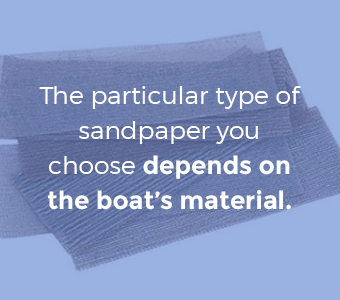
Once you’ve scraped off all of the peeling paint, it’s time to sand and feather the edges around those areas to get the surface as smooth as possible. Put on your mask and protective glasses to avoid inhaling toxic paint chips and sawdust. Use a random-orbit or finishing sander, like our Mirka Pneumatic Random Orbital Finishing Sander , but never a belt sander, which is sure to do more damage than good. You’ll want a rough sandpaper to get the job done — somewhere between 80- and 100-grit.Once you’ve scraped off all of the peeling paint, it’s time to sand and feather the edges around those areas to get the surface as smooth as possible. Put on your mask and protective glasses to avoid inhaling toxic paint chips and sawdust. Use a random-orbit or finishing sander, like our Mirka Pneumatic Random Orbital Finishing Sander , but never a belt sander, which is sure to do more damage than good. You’ll want a rough sandpaper to get the job done — somewhere between 80- and 100-grit.
The particular type of sandpaper you choose depends on the boat’s material. We recommend Mirka Abranet sandpaper , which relies on flexible fabrics with breathable, net-mesh designs. Breathable means this sheet provides dust-free sanding for materials ranging from aluminum to carbon steel. If you’re working with wood, Mirka Bulldog Gold Proflex Sandpaper has aluminum oxide grain, which gives you a good cut and excellent scratch pattern.
How to Prime a Boat
Once you’ve prepared the surface and have a clean, smooth surface free of peeling paint, you’re ready to prime the boat. While our directions are for two coats of primer, please note you may need to repeat filling and sanding a few times, depending on the number of dents and low spots you have.

- Wipe surface with a tack cloth.
Regardless of whether you use dust-free sandpaper and/or a vacuum to collect the dust, you still want to follow your sanding and feathering with a tack cloth. This cloth has just enough of a tacky finish on it to remove any remaining loose particles, leaving you with a flawless finish.
- Apply the first coat of primer.
Once you’ve wiped down the entire area with a tack cloth, it’s time to apply your first coat of primer. Resist the urge to apply a thick coat — instead, paint on just enough to cover the surface of the area you’re going to paint. Let the primer dry. Make sure you follow the manufacturer’s instructions for drying time and time between coats. Don’t panic if you can see uneven spots on the surface — we’ll address that in the next step.
- Fill low spots with epoxy.
Inevitably, you’ll notice uneven spots on the surface — maybe left over from dents or peeling paint you tried to sand out. Once the primer has dried, it’s time to touch up these low spots with epoxy. Using your putty knife, apply the epoxy and do your best to evenly spread it over the low areas, creating a surface that’s as even as possible. Then, let the epoxy cure.
- Lightly sand.
Once the epoxy has cured, you want to lightly sand the area with a higher-grit sandpaper, something close to 320-grit, to get a completely smooth surface. We recommend using Mirka Waterproof Sanding Sheets , specifically designed for wet sanding — just in case the epoxy isn’t 100 percent cured, this sandpaper will still get the job done without worrying about creating a mess.

- Wipe with a tack cloth.
Once you’ve sanded the epoxy, wipe the entire area down with a tack cloth. You should reveal a smooth surface, free of low spots and dents. If you discover the area is completely smooth, move on to the next step. If you still see some low spots that could be improved, fill them with epoxy and repeat until you have a smooth surface.
- Apply a final coat of primer.
When you finally have a smooth surface, apply your final coat of primer and remove the tape while the primer is still wet. Let it dry — again, making sure you follow the manufacturer’s instructions for drying time and time between priming and painting. This final coat of primer should even out the color over the already seamless surface, proving your preparation is complete and you are finally ready to paint your boat.
How to Paint a Boat
The preparation is officially complete once the final coat of primer has dried. Now, it’s time for the final set of steps to complete your project — painting your boat.
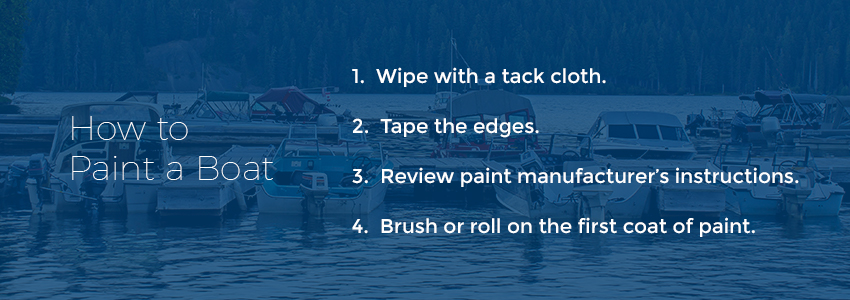
Once your primer has dried, wipe the entire surface down with a tack cloth, removing any loose dust or dirt that has accumulated.
- Tape the edges.
Once you’ve wiped down the entire area, tape the waterline and along the top edge of the topside. Again, be sure to use long-mask tape. In addition to taping the waterline, consider covering the boat bottom or antifouling area.
- Review paint manufacturer’s instructions.
Since there are different types of topside boat paints, it’s important to remember to consult the manufacturer’s instructions before you begin painting. Some paints require thinner or have other specific mixing instructions. You want to make sure you’re following every piece of advice the manufacturer gives you before you begin to apply the first coat of paint.
- Brush or roll on the first coat of paint.
Once you’re certain you have read the manufacturer’s instructions and have mixed the paint accordingly, it’s time to apply your first coat. The majority of topside paints can be rolled or brushed on, but again, the deciding factor should be whatever the manufacturer recommends. Begin by rolling or brushing perpendicular to the waterline, making sure to take shorter strokes and covering only a small area at a time. Then, brush or roll parallel to the waterline to finish. Let the paint dry and apply additional coats per the manufacturer’s instructions.
- Remove the tape.
Before the final coat of paint is dry, remove the tape. Waiting until the final coat is dry puts you at a higher risk of peeling paint along with the tape, causing you to have to start some of the preparing and painting processes all over again.
Painting the Deck and Bottom of the Boat
While there are a lot of similarities when it comes to preparing and painting the deck and bottom of your boat, there are also some notable differences.
The deck of your boat is likely a combination of fiberglass and non-skid surfaces. On the deck, it may not be possible to remove several pieces of hardware. In that case, you should meticulously tape off all the hardware and cover upholstery and electronics. Aside from that, the preparation and painting are very much the same, except for the non-skid surfaces. When these areas are damaged, you have two options — stick an entirely new non-skid surface over them, or paint them with a paint that contains a non-skid compound.

The bottom of your boat has maximum exposure to the water and all the growth and organisms living in it — so the paint selection for the bottom of your boat is different. What is bottom paint on a boat? Bottom paints contain a biocide, often in the form of copper, that is meant to continuously slowly fade away to expose more of the biocide, which prevents barnacles and other marine growth. For more information on bottom painting a boat, visit our how-to guide for painting the bottom of a boat.
Paint Your Boat Propellers and Running Gear
We’ve covered the topsides, deck and bottom of a boat, but should you paint your boat propellers and running gear? While the appearance of your propeller and running gear may not be a high priority, the performance is a top priority.
If you’ve been wondering how to keep marine growth from fouling your propellers, painting it just might be the answer. Applying a foul release coating to these areas can improve performance and protect your boat propellers by preventing the buildup of weeds, barnacles and more by creating a super-smooth hydrophobic surface marine life can’t latch onto.

By painting a foul release coating onto your propeller and running gear, you can expect to:
- Improve acceleration and maintenance of speed. The ultra-smooth surface creates less friction, which decreases drag and resistance, resulting in more knots.
- Decrease fuel consumption. Even the slightest buildup on your propeller and running gear causes more fuel to be used to compensate for the loss in speed and engine power.
- Reduce cavitation. An unhindered surface causes less disruption in the propulsion, and therefore causes fewer air bubbles.
- Eliminate the need for biocide and produce fewer CO2 emissions. Poisonous biocides aren’t necessary with this slippery surface, and the reduction in drag also means fewer CO2 emissions are produced.
Different Types of Topside Boat Paints
As a whole, topside paints are similar. Meant for use above the waterline, they’re durable, resistant to moisture, can endure hull expansion and contraction and resist UV rays. The differences between the types of topside boat paints are in how well they rank in each of these areas.
- Two-part polyurethane paints outperform every other topside paint when it comes to hardness, scratch and UV ray resistance and gloss and color retention. Why not stop here? Because it comes with a price tag to match. In addition to being the most expensive topside paint, it also requires very specific primer and application equipment.
- One-part polyurethane paints are perfect for do-it-yourselfers. While they don’t quite have the performance of two-part polyurethane, they’re easy to apply and provide a beautiful shiny gloss finish. They’re affordable, safer to mix and apply and easy to touch up.
- Alkyd marine enamel paints are very popular because they’re easy to apply, glossy and affordable. They require fewer coats, but will require a fresh coat each year, as they aren’t as durable. Their oil base makes them a great match for wood, and they’re easy to touch up.
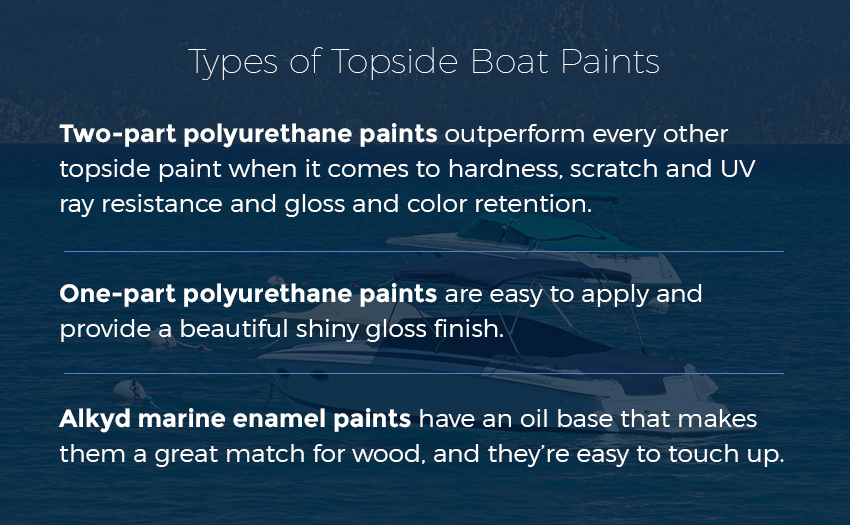
It’s important to remember that regardless of which type of topside boat paint you choose, you’ll need to check compatibility with the paint that’s currently on your topside. Two-part polyurethane paints, for example, can only be painted over other two-part paints. If you’re unsure what topside paint is currently on your boat, you can do a solvent test to check or strip the entire topside before painting.
National Abrasives, Inc.
At National Abrasives, we’re here to help you prepare your boat for painting, so it looks like new. Our random-orbital finishing sanders and Mirka specialty sandpapers will get every part of your boat ultra-smooth as you prepare to paint it. Take advantage of our bulk discounts free shipping and excellent customer service to make sure you always have what you need to prepare and paint your boat for the next season. Contact us to discuss your boat preparation needs, and we’ll recommend the products that will work best for you.
- PO Box 315, Lewisberry PA 17339
- 717.697.6776 | 800.459.8008
- [email protected]
VISIT OUR HEADQUARTERS
- 941 Mt Airy Rd, Lewisberry, PA 17339
- Open M-R 8am - 4PM Friday 8am-2pm
Shop Securely Online
- Request Credit Application

Ridetheducksofseattle is reader-supported. When you buy through our links, we may earn an affiliate commission. Learn more
How to Paint a Sailboat? Expert Tips and Techniques
Written by Anthony Roberts / Fact checked by Jonathan Larson

Some folks don’t like their sailing vessel’s color, so they may want to learn how to paint a sailboat DIY style. Or maybe the boat needs a retouch for a brand-new and more vibrant look while on the sea.
Regardless of the reason, this easy-to-follow sailboat painting guide will help you splash colors and breathe life into your sailing vessel. The steps are straightforward, although patience is essential.
Let’s start.
Table of Contents
Step 1. Clean and sand the sailboat.
Step 2. apply primer on the sailboat’s hull., step 3. get the paint ready., step 4. apply the paint., sailboat maintenance tips , ways to paint a sailboat.
Painting a sailboat is like coloring any object. It requires preparation, elbow grease, and commitment to complete the job.
Things you’ll need:
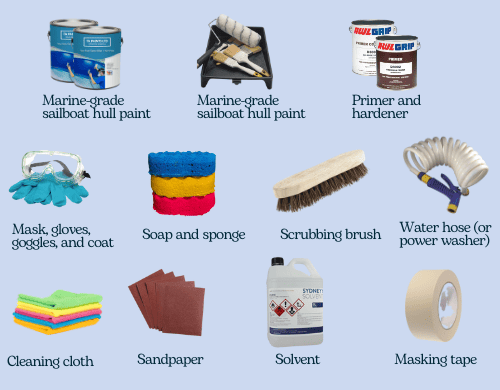
- Marine-grade sailboat hull paint
- Paint roller, brush, and paint tray
- Primer and hardener
- Mask, gloves, goggles, and coat
- Soap and sponge
- Scrubbing brush
- Water hose (or power washer)
- Cleaning cloth
- Masking tape
We understand painting a sailboat can be intimidating for beginners. It can be a fun experience (though tiring), too. So, we prepared a four-step process to make this activity as easy to follow as possible.

Surface preparation is crucial in any paint job. You’ll want a clean, contaminant-free, and smooth surface to ensure the paint adheres to the hull. Here’s how to get your sailboat ready for a paint job.
- Wear your protective gear.
- Check for any signs of damage and repair them accordingly.
- Spray your sailboat clean using a power washer or a hose until the hull is free of dirt, grease, barnacles, etc.
When encountering stubborn objects, scrape them off with a scrubbing brush.
- Create a soapy solution and moisten the sponge. Scrub the boat with the cleaning agent to remove stains.
- Rinse thoroughly.
- Once dry, roughen the boat with 80- to 100-grit sandpaper. Finish the job with 220-grit sandpaper to smoothen the surface.
Pro Tip: Use an orbital sander with a 40- to 80-grit sanding disc for better results.

A paint primer is crucial for any painting project, whether by hand or machine. This initial coat gives the boat paint something to “cling” to, ensuring it lasts longer than a primer-less surface.
- Remove all the hardware from the vessel.
- Cover sailboat trims and other elements you wish to leave unpainted. The tape’s straight edge also guarantees more uniform coats.
- Combine the epoxy polymer and hardener following the brand’s instructions.
- Pour the mixture into the paint tray and run the roller to coat it with the priming solution.
- Apply the primer on the sailboat’s hull, covering every square inch.
- Leave the primer to dry for about a day.
- Repeat the primer application three more times, allowing each coat to dry for a day before applying the next layer.
- Lightly sand the primed surface with 300- to 400-grit sandpaper until the boat is smooth.
- Dip a clean rag into a solvent, such as mineral spirits and xylene, and wipe the boat again.
Pro Tip: Use a small paintbrush to apply primer on corners and other areas the paint roller cannot reach.
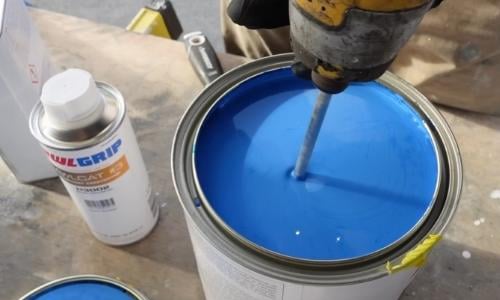
You can either retouch your boat with acrylic paint or a marine-grade variant.
- Acrylic is water-based. Therefore, applying it on a boat might not provide adequate waterproofing, which can result in premature peeling.
However, acrylic paint has the advantage of drying quickly and containing less toxins. To mitigate its drawbacks, you can apply a waterproof coating as the final layer.
- Marine-grade paint is usually the preferred choice, as it’s waterproof, UV-resistant, and salt-resistant.
That said, marine-grade paint is not for easy sailboat painting since it’s a lot harder to apply and requires meticulous handling. In addition, it’s also pricier than acrylic paint.
In either case, please follow the paint manufacturer’s instructions on preparing and mixing the pigment.
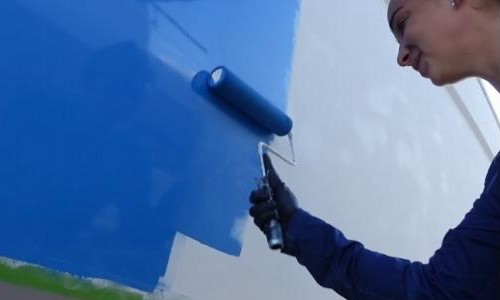
You’re ready to apply paint colors to your sailboat. This step might vary a bit depending on the paint manufacturer. Hence, we highly recommend reading the painting instructions.
- Hose down the area you’re working to settle the dust.
- Pour the boat paint into the tray and lightly dampen the roller with water.
- Immerse half the roller into the paint can and run it several times on the tray for even distribution.
- Paint the sailboat’s hull, ensuring firm and even pressure. Maintain uniform strokes.
- Dip the paintbrush into the paint and remove excess pigment. Paint areas the roller cannot reach.
- Leave the paint to dry following the manufacturer’s recommended curing time.
- Smoothen the surface with 400-grit sandpaper (you can use finer-grit sandpaper). However, you might want to check the paint manufacturer’s guidelines if this step is necessary.
- Apply a second and third paint coating, ensuring the recommended drying time between applications.
Pro Tip: Apply two layers of top coat and antifouling paint to make your DIY sailboat paint job last longer.
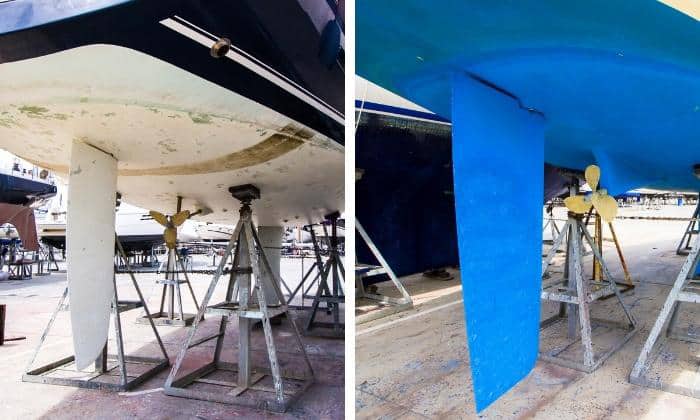
Maintaining a sailboat is crucial because it prolongs its lifespan and boosts its resale value. After all, nobody would want to buy a barnacle-ridden, stain-filled watercraft.
- Wash and clean your sailboat periodically with mild, boat paint-friendly cleaners to avoid removing the paint’s protective coating.
- Use soft water when cleaning the sailboat because hard water can strip pigments off the hull.
- Apply a marine-grade UV protectant or sealer after every wash to leave the sailboat looking pristine and brand-new.
- Repaint a boat with marine-grade pigments at least once annually, especially if you don’t take it out of the water and notice telltale signs of damage or deterioration.
- Choose a sailboat paint to meet your needs. For example, gelcoat paints are ideal for creating a mirror-like finish but require frequent reapplication. Meanwhile, polyester-based topcoat paints can produce gelcoat-like finish but last longer.
Learning how to paint a sailboat offers many benefits beyond extending your watercraft’s lifespan, allowing you to enjoy more leisurely cruises with your loved ones. Painting a boat can be relaxing and rewarding, too. It unleashes creativity and empowers you to be more productive.
However, painting a sailboat takes time, although the process is easy. And if you are a busy bee, you’re better off handing this task to the pros. The results might even be better, except nothing can bring more joy than a project you complete with your hands.

I am passionate about water sports and technical fields, so combining both makes me interested in making contents about boat accessories. With my partner, we went on many trips and sports games together, which led us to think about how we can spread our joys and passions to many people.

- Forums New posts Unanswered threads Register Top Posts Email
- What's new New posts New Posts (legacy) Latest activity New media
- Media New media New comments
- Boat Info Downloads Weekly Quiz Topic FAQ 10000boatnames.com
- Classifieds Sell Your Boat Used Gear for Sale
- Parts General Marine Parts Hunter Beneteau Catalina MacGregor Oday
- Help Terms of Use Monday Mail Subscribe Monday Mail Unsubscribe
Painting the inside
- Thread starter nameaneh
- Start date Feb 22, 2009
- Forums for All Owners
- Ask All Sailors
I want to repaint the inside of my sailboat. I was wondering what, if any, special paint I need to paint to the fiberglass portion. It's inside so I don't want to buy really expensive paint. Thanks
A single part urethane should work nicely. Interluxe's Brightsides if you want "marine" paint. Otherwise you can save some money at your local Benjamin Moore or Sherwin Williams. Plus they have a better color selection.
Any good brand name industrial enamel will do fine.
In a similar post recently someone said they used Oil based "Kilz" with very good results! We are going to strip the old fabric type wallpapery type stuff off the walls and paint with the Kilz and sponge on some light blue in splotches. Jack
if you want something along the lines of Brightside without the cost, consider going to Home Depot and get Glidden Porch and Floor paint. You have color options if you like and this is the same paint as Brightside for a fraction of the cost. This is a NON linear polyurethane.
I have come to the conclusion that the Home Depot/Lowes single part urethanes are pretty good. I have been using the urethane porch and deck enamels, with good success. And you can get them in any color you like, as well as being able to match any color.
Thanks everyone... Can I use the Glidden porch and floor paint for the outside above the waterline???? That would be great if I could.
And if I can, do you just sand then apply or do I HAVE to prime?
Stu Jackson
An old sailor's trick from Lin & Larry Pardey, I think: if you paint the insides of a boat white, it'll look a heck of a lot better, and seem a little bit cooler if you pitch a small amount of blue tint into the gallon jar.
Outside Paint I recently did the hull with the same urethane porch and deck enamel. Just sanded and painted, no primer. So far so good.
Chris Burti
House Paint We painted the interior of our old Cal 27-T/2 with white semi-gloss Exterior Latex house paint with a mildewcide additive in 2001 after spraying the interior with house cleaner mixed with bleach and then pressure washing (obviously, empty the boat first). We painted all interior surfaces (except the teak) and the interior of all lockers. It looked great and the current owner has it listed for sale and is advertising the interior refurbishment...so it has held up well.
jackhartjr said: In a similar post recently someone said they used Oil based "Kilz" with very good results! We are going to strip the old fabric type wallpapery type stuff off the walls and paint with the Kilz and sponge on some light blue in splotches. Jack Click to expand
Kilz is a supurb primer but it should be top coated. The nice thing about paint is that if you don't like the color you can change it for less than the cost of dinner out for two.
r. gallagher
Paints and primers Just some advice from someone that used to run a SWP store: If you use Kiz primer be sure to have the area very well ventilated. Kilz can make you nauseaus and light headed if not ventilated. It is a very good primer / blocker and paint adheres very well to Kilz. I have used it inside and out with excellent results. Bullseye primer is another choice. I have seen it used on glass and the paint was top coated over the Bullseye. The pain could not be peeled off the glass. As far as exterior paints, I would try to stay away from an exterior house paint because of some of the properties that make it goos for house exteriors. It will also always be a little soft which is why it is easy to recoat after years. Oil based will give a harder finish but is more brittle that lastex.
rgallagher, you are right about the Kilz putting off fumes, we enclosed a garge and used it and I just used it to 'lighten/whiten up a small storage building. WWHHEEWW. Thanks for pointing that out. Jack Ross, good point on covering the Kilz with paint, will do when I paint the interior. Jack
Re: Paints and primers The modern formulations of direct to metal machine enamels are pretty had to find fault with. The local McCormack store has used it very successfully for painting the warehouse floor in the back of the store. After 4 years it is difficult to find and wear patterns in the paint.
[email protected]
Painting Keep one thing in mind. With very few exceptions The best (in YOUR opinion) paint/finish product is the least expensive. It usually lasts the longest, which means less time refinishing and more time to use your boat. You have to do your own product research and decide for yourself. I took some advice in the past and was disappointed with the results. My opinion, my own fault. I would only paint fiberglass as a last resort. There are plenty of cleaners, polishes and waxes available. I use Turtle Wax in a green squeeze bottle on the interior fiberglass. I use a 3-M cleaner/polisher on the topsides; and I buff each area within 10 minutes. In my case I would never paint the pretty woodwork (brightwork), nor fiberglass inside nor exterior. Once you start you can never stop. I just recently used WATCO brand teak oil, (NOT Fornby's Tung oil) that I got at Lowe's on my interior woodwork. I used this on a mild, sunny and very breezy(25 Knot with 50 Knot gusts) It was dry and sunny. A clearing weather system. I opened all the hatches and ports. I turned on all the cabin fans to keep up the ventilation. I applied the finish with an old T-shirt and rubbed it into the wood grain to the point that it would saturate the dry wood, but not run. You don't want to use a brush. Too many stroke marks. The wood soaks up the teak oil and the finish dries quickly with a well ventilated cabin. My boat, Ladybug, is a 35.5 Ft Hunter Legend. It took four hours to do the interior woodwork, including moving cushions, etc.. She shines nice and bright!
Re: Painting Before it was Watco teak oil it was Varithane penetrating oil and sealer. I have used it for years and I have never had occassion to find fault with it.
Larry Neese
you might try Pettit "Easy Poxy" great color selection, easy to apply and designed for marine environment, use the undercoater for a great finish, but I agree to only paint it if it is the last resort. $34.00 per quart
Brian M H23
I used a bright white epoxy-based garage floor paint as bilge paint. I don't see any reason why it wouldnt work for the rest of the backside of the fiberglass!
- This site uses cookies to help personalise content, tailor your experience and to keep you logged in if you register. By continuing to use this site, you are consenting to our use of cookies. Accept Learn more…

Please verify you are a human
Access to this page has been denied because we believe you are using automation tools to browse the website.
This may happen as a result of the following:
- Javascript is disabled or blocked by an extension (ad blockers for example)
- Your browser does not support cookies
Please make sure that Javascript and cookies are enabled on your browser and that you are not blocking them from loading.
Reference ID: eaab5a98-e5f0-11ee-8484-b179e9b07623
Powered by PerimeterX , Inc.

How Much Does It Cost To Paint The Hull Of A Sailboat?

Last Updated by
Daniel Wade
June 15, 2022
Sailboats are designed to be exposed to the harshest of elements – water. As such, there is much more to painting the hull that choosing a color and slapping it on. A quality hull painting job will take time and have a range of cost involved. Hull painting is more than simply decorative, it is also protective.
Table of contents
Do I Need To Paint My Hull?
There are instances where the bottom painting isn’t necessary. If your boat is typically stored in a dry storage facility or on a trailer and only hits the water for a short time, you can opt not to paint. In these cases, your boat hull can be properly maintained with a heavy coat of wax and periodic cleanings. For most other boats that are docked in the water or see heavy off land use, bottom painting is essential.
Once you have made the choice to paint your hull, you must maintain it with periodic cleanings, paint removal and repainting with antifouling paint . This will help preserve the integrity of your hull intact and in proper operational condition.
What Is Antifouling Paint?
If your boat is usually stored in a dry storage facility or on a trailer and only hits the water for a short time, you can opt not to paint. This paint is applied all along the bottom of the hull up to the water line of the boat. This paint helps to protect the boat from various forms of water-based damage that can occur. Hull paint also prevents barnacles, weeds and other water-based life from attaching to the bottom of the sailboat.
Just like with regular paint there is a diverse range of brands, styles, and colors to choose from. Aside from these options, there are three types of antifouling paint; hard, hybrid, and ablative. The type you choose largely depends on the type of sailboat you have and your overall budget.
Hull Paint Types
Hard bottom paint is best for powerboats or other fast moving boats. It is a longlasting coating that is very hard and has a thick layer of biocide. The biocide layer wears away over time which allows the hull paint to last longer prior replacement. Once the biocide has been depleted, however, the hull must be repainted.
Ablative paint is well suited to casual boats and slow-moving sailboats. Unlike hard bottom paint, this type wears away directly over time. As the paint wears away while moving through the water, it releases more biocides. Many boaters call this paint self-polishing. As the paint wears thin on the hull, it will need to be replaced. Since there is less paint to remove, repainting the hull is easier and tends to be more affordable.
Hybrid paint is exactly what the name implies. It is a mix of both hard and ablative paint and can be used on all types of sailboats.
How Much Does It Cost to Paint a Sailboat?
Now that you recognize some of the basics about the need for hull painting as well as the main types of paint available, we can cover the cost. When it comes to hull painting, you can hire a professional or you can do it yourself. Just like most hobby projects, compared to hiring a professional you will save money. On the other hand, having your hull professionally painted will cost you more, but it will take less time and come with a guarantee.
DIY Hull Painting
A certain peace comes from caring for your sailboat with your own hands. If you choose to take on the task of painting your hull on your own, make sure to plan adequately and give yourself plenty of time to get the job executed properly. Though you can expect to pay less when you do it yourself, the cost still will vary widely. The main expense depends on the amount of paint you need and the type of paint you choose for your hull.
Hull paint is sold in one-gallon containers and can range from $20 - $200 per gallon. The price range depends on primarily the brand and style of hull paint. Aside from the paint, you will also need to budget for painting supplies such as;
- Paintbrushes
- Drop Cloths
- Paint trays
- Masking tape
- Breathing mask
The size of your boat will determine how much product you need, and each brand list the amount needed per linear foot on the can. The majority of ablative hull paints will require two coats and modified epoxy hull paints only require one coat. Make sure to keep these in mind when calculating your cost.
- Single coat paints for boats that are between 20 – 35 feet will need 1 ½ gallon of paint.
- Double coat paints for boats that are between 20 – 35 feet will need 3 gallons of paint.
- Single coat paints for boats that are between 36 – 35 feet will need 3 ½ gallons of paint.
- Double coat paints for boats that are between 36 – 51 feet will need 6 gallons of paint.
- Single coat paints for boats that are between 53 – 63 feet will need 4 ½ gallons of paint.
- Double coat paints for boats that are between 53 – 63 feet will need 9 gallons of paint.
Professional Hull Painting
Hull painting by a professional starts off with a base cost that is determined by the size of your sailboat. As of 2019, the average cost per linear ft falls around $25 for basic selections which can range up to $125 per linear foot for premium selections. Boats that need more work or additional repairs may incur an additional cost.
Customarily, professionals will charge a moderately lower rate for larger boats over smaller ones. There are also cost involved with where your boat will be painted. Sailboats that must be blocked, stored or transported prior to painting will incur heftier fees than those on a trailer or stored on a personal slip. Older boats that have damage to the hull or other defects will need to be repaired prior to painting the hull which can also increase the cost. Virgin hulls, basically ones that have never been painted before will cost less to complete since there will be no need to have a paint removal service completed.
Depending on your boat size and your exact location, you can expect to pay the following estimated rates for basic hull painting & premium hull painting.
- $25.00 per linear ft. – 29′ sailboat + $155.00 for premium upgrades
- $29.00 per linear ft. – 30′ to 36′ sailboat + $190.00 for premium upgrades
- $34.00 per linear ft. – 37′ to 43′ sailboat + $250.00 for premium upgrades
- $38.00 per linear ft.. – 44′ to 49′ sailboat + $330.00 for premium upgrades
- $43.00 per linear ft. – 50′ to 54′ sailboat + $400.00 for premium upgrades
- $49.00 per linear ft. – 55′ to 59′ sailboat + $490.00 for premium upgrades
- $56.00 per linear ft. – 60′ and larger sailboats + $555.00 for premium upgrades
The Bottom Line
When it comes down to it, the cost of painting your sailboat hull is neither excessive or unmanageable. You have a range of options that will allow you to choose the best paint and finish for your hull that falls within your personal budget. Caring for your hull will ensure you get the most use out of your sailboat for years to come. Proper hull maintenance will prevent the growth of waterborne pests such as slime and barnacles while also giving your boat a sophisticated appearance. We wish you smooth sailing ahead and hope to see you again soon!
Related Articles
I've personally had thousands of questions about sailing and sailboats over the years. As I learn and experience sailing, and the community, I share the answers that work and make sense to me, here on Life of Sailing.
by this author
Repairs and Maintenance
Financial and Budgeting
Most Recent

What Does "Sailing By The Lee" Mean?
October 3, 2023

The Best Sailing Schools And Programs: Reviews & Ratings
September 26, 2023
Important Legal Info
Lifeofsailing.com is a participant in the Amazon Services LLC Associates Program, an affiliate advertising program designed to provide a means for sites to earn advertising fees by advertising and linking to Amazon. This site also participates in other affiliate programs and is compensated for referring traffic and business to these companies.
Similar Posts

Best Bluewater Sailboats Under $50K
December 28, 2023

How To Choose The Right Sailing Instructor
August 16, 2023

Cost To Dock A Sailboat
May 17, 2023
Popular Posts

Best Liveaboard Catamaran Sailboats

Can a Novice Sail Around the World?
Elizabeth O'Malley

4 Best Electric Outboard Motors

How Long Did It Take The Vikings To Sail To England?

10 Best Sailboat Brands (And Why)
December 20, 2023

7 Best Places To Liveaboard A Sailboat
Get the best sailing content.
Top Rated Posts
Lifeofsailing.com is a participant in the Amazon Services LLC Associates Program, an affiliate advertising program designed to provide a means for sites to earn advertising fees by advertising and linking to Amazon. This site also participates in other affiliate programs and is compensated for referring traffic and business to these companies. (866) 342-SAIL
© 2024 Life of Sailing Email: [email protected] Address: 11816 Inwood Rd #3024 Dallas, TX 75244 Disclaimer Privacy Policy

IMAGES
VIDEO
COMMENTS
Learn why, when, and how to paint your sailboat yourself. Find out the benefits, tips, and best paints for your boat's hull and top.
Hello my creative friends! In this acrylic painting tutorial we will go step by step to learn how to paint a sailboat in the ocean. Thank you to my awesome p...
Consider these steps: 1. Choosing the Right Primer: Select a primer that is compatible with the type of paint you'll be using and suitable for the boat's material. 2. How to Apply Primer: Follow the manufacturer's instructions and apply the primer evenly across the entire surface of the sailboat.
This video shows how to paint a sailing boat in watercolor. It´s simple and easy, for beginners. Get my drawing book: http://amzn.to/1K7L8EdFollow my Instagr...
Learn how to paint a sailboat scene in this, step by step, acrylic painting tutorial with artist Ashley Krieger. This lesson will teach you the steps to take...
Practical Steps for Painting a Sailboat. Step 1. Give the sailboat a thorough cleaning. Step 2. Start sanding the hull's surface. Step 3. Prepare the primer, then apply it. Step 4. Prepare the paint, then start applying the topcoat and antifouling coat.
Blocking in the background is an important step in painting a sailboat with acrylics. It establishes the composition and sets the tone for the rest of the painting. Here is a step-by-step guide on how to block in the background: 1. Choose the colors for the background based on the atmosphere and mood you desire.
To paint your boat successfully, you'll need a range of tools and materials, including paintbrushes, rollers, sandpaper, masking tape, drop cloths, and, most importantly, the appropriate marine paint. Preparing the boat surface. Proper preparation is the key to a successful paint job. Start by cleaning the boat's surface thoroughly to remove ...
Sailing is one of my favorite things to do and painting sailboats is almost as fun! This lovely sailboat flew in the wind on Somes Sound on Mount Desert Island, Maine. It was one of those perfect sailing days. The light sparkled, the wind blew steadily and the last of summer heated the air.
Prep the surface by washing, de-waxing, and thoroughly sanding it. Apply the primer, then the paint. Wax the boat from stem to stern to protect the new paint job. Then, simply keep it clean, and rinse it thoroughly after use in saltwater. Remember, before you paint a boat always read the warning labels on all of the supplies and be sure to use ...
Use a high-pressure hose, a scrapper, and rags to make the boat spotless. 2. Remove hardware from the boat. You want to take off as much as possible, down to any aluminum window siding. This could cause a crease between the hardware and the paint, which will allow water to get into the cracks and ruin the paint.
Painting a sailboat on canvas allows for creativity and expression: Painting a sailboat on canvas provides an artistic outlet to capture the beauty of the sea and sailing while expressing individual style and interpretation. Importance of using the right materials and tools: To achieve desired results, it is important to gather the necessary ...
Apply primer, if necessary, and resand. Apply the finish paint with a partner, using roller and brush. Let each coat dry completely before lightly sanding for the next, laying on a minimum of two coats. Protect yourself and the environment. A smooth application of bottom paint helps boat performance.
In today's acrylic painting tutorial we paint a seascape depicting a sailboat out on the reflective water. This relaxing painting lesson is completed for the...
Then Janet used a solvent wash to ensure a strong bond with the primer paint. 3. After dings and cracks were repaired and sanded, two coats of epoxy primer were applied. 4. Following another round of sanding, vacuuming, cleaning, and taping, the couple rolled and brushed on a fresh coat of Awlgrip topcoat. 5.
Apply the first coat of primer. Once you've wiped down the entire area with a tack cloth, it's time to apply your first coat of primer. Resist the urge to apply a thick coat — instead, paint on just enough to cover the surface of the area you're going to paint. Let the primer dry.
Painting a boat can be relaxing and rewarding, too. It unleashes creativity and empowers you to be more productive. However, painting a sailboat takes time, although the process is easy. And if you are a busy bee, you're better off handing this task to the pros. The results might even be better, except nothing can bring more joy than a ...
Learn how to choose the best sailboat bottom paint for your boat based on your location, type, and fouling condition. Compare the features, pros, and cons of 10 top-rated bottom paints for freshwater and saltwater sailing.
Dec 2, 2003. 480. Catalina C-320 Washington, NC. Feb 23, 2009. #11. House Paint. We painted the interior of our old Cal 27-T/2 with white semi-gloss Exterior Latex house paint with a mildewcide additive in 2001 after spraying the interior with house cleaner mixed with bleach and then pressure washing (obviously, empty the boat first). We ...
Get this FULL SERIES here: https://www.offcenterharbor.com/yt-boat-paint-2204/Get a grip on how to paint a boat — before you head off to the marine paint sto...
Interlux's Boat Paint Guide and Color Chart (Model 5422381) and Pettit's Boat Painting Guide (Model 10484244) are two examples, available for free download below. Also, several of our major paint suppliers list toll-free phone numbers that you can call during business hours for help. Finally, of course, our West Marine Product Advisors are ...
Depending on your boat size and your exact location, you can expect to pay the following estimated rates for basic hull painting & premium hull painting. $25.00 per linear ft. - 29′ sailboat + $155.00 for premium upgrades. $29.00 per linear ft. - 30′ to 36′ sailboat + $190.00 for premium upgrades.
Check out the full article: http://www.boats.com/how-to/how-to-paint-a-boat/Watch How to Prep a Boat for Painting: http://www.boats.com/how-to/maintenance/ho...
sockodough on March 18, 2024: "Beret Hat, 2024 Bliss, 2024 It's mine, 2024 Paper boat, 2024 Mixed media on linen 12 x 9 in 30.5 x 22.9 cm Walnut Frame #painting..."